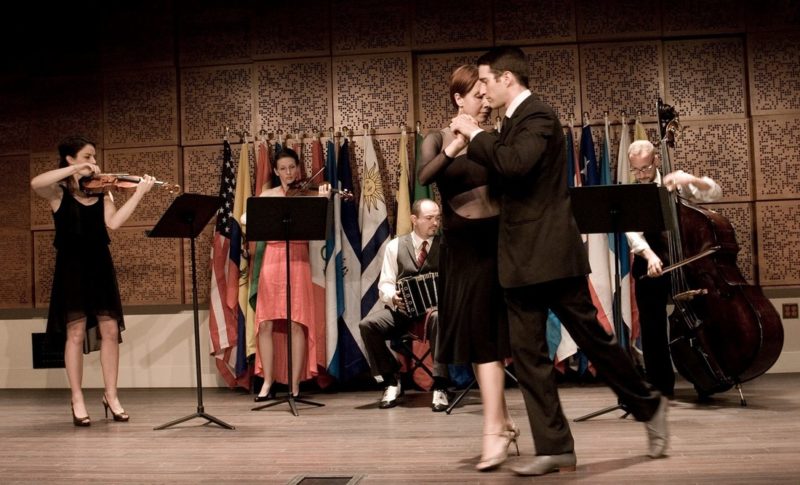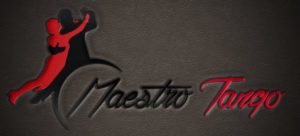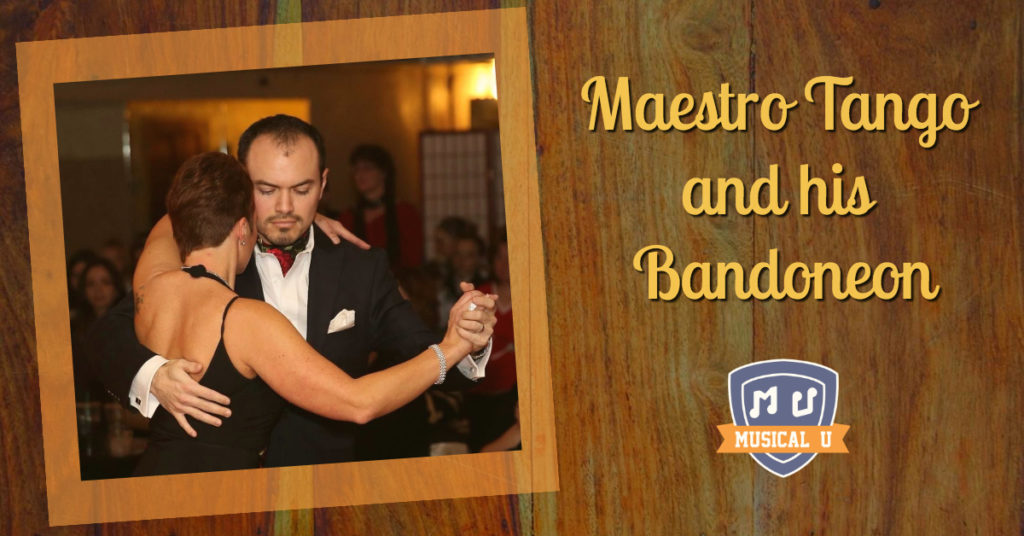Born and raised in Mérida (Yucatán, México) and now based in the USA, multidisciplinary artist and educator Alejandro Pinzón – aka Maestro Tango – specializes in Argentine tango. An orchestra conductor, tango dancer, bandoneon and violin player, lecturer, photographer, and tango DJ, he travels internationally providing dance instruction and workshops, performing tango concerts, teaching master classes, and leading interactive lectures about Argentine Tango.
While an accomplished violinist, bandoneon is his true passion. With its searing melodic timbre and percussive drive, this oddball free-reed instrument, somewhat resembling the accordion, stars in the traditional tango ensemble.
We asked Alejandro about his instrument and about his tango journey:
Back in my hometown of Mérida, I started playing as a violinist for various ensembles. I never played mariachi music, but oddly enough, I’d play Argentine tango with some frequency.
 Fast forward to 2007, I was studying for my master’s degree in conducting at the University of Texas at El Paso. I went back home to premiere “Lazos de Tango“, a music-dance show where I did the first Mérida performance of Astor Piazzolla’s “Four Seasons”.
Fast forward to 2007, I was studying for my master’s degree in conducting at the University of Texas at El Paso. I went back home to premiere “Lazos de Tango“, a music-dance show where I did the first Mérida performance of Astor Piazzolla’s “Four Seasons”.
I played violin for that. We had a bandoneon player and outstanding dancers. That was the aha! moment for me. Dancing came immediately after – and the bandoneon bug too.
However actually acquiring an instrument had to wait for several years.
I could write a full article about this. Actually, I did, and you guys kindly shared it in a previous article. It’s called “Bandoneón, Why?”
But, if you want a brief answer, I love the great technical challenges of the instrument. I know I sound a bit nerdy, but really, it’s quite difficult to play it and I love discovering its intricacies. On the other hand, there’s something mesmerizing about it. I believe it’s the only instrument you sit on your lap, while playing with two hands (each hand plays different keyboards) and balancing it with your legs.
Fortes are accomplished by using your core and literally pushing or pulling the instrument (the bellows) with strength. There’s a sensation of power when doing it, and its sounds resonate in your body. It’s a magical experience for me. It’s like dancing tango!
 At first glance, there’s nothing in common. One is a string instrument and the other one a free reed, but over time, I’ve found common ground. I apply my bow technique to control the bandoneon’s bellows. They feel “the same” to me. String players reading this interview will understand about the “bow pressure”.
At first glance, there’s nothing in common. One is a string instrument and the other one a free reed, but over time, I’ve found common ground. I apply my bow technique to control the bandoneon’s bellows. They feel “the same” to me. String players reading this interview will understand about the “bow pressure”.
Woodwind and brass players experience it with their air column. The bellows function is remarkably similar. The expression of your sound comes from you controlling the bellows, the way you would control a bow. Vibrato on a string instrument? You manipulate it with your left hand/arm… same on bando! Odd enough, on the bandoneon, I can vibrate easier with my right hand.
Well, there’s the hand thing with the vibrato. Also, the buttons (“keys”) on the bandoneon are tuned already. Its two keyboards have no logical arrangement and every button (70+ of them) has two different pitches, one when pushing, one when pulling (like a harmonica). It’s quite… “fun” remembering where every sound is!
Of the two, music was my first love. I’m not ashamed to say that I was that teenager who “hated” dancing and would sit at a party taking care of my friends’ purses. It was during the tango show in 2007 that I took my first dance lessons.
My music mentor at the time wanted me to conduct one of his contemporary ballets, which I eventually did. The one condition was to learn how dancers think… by way of learning how to dance.

I was not particularly interested in, hmm, any dance at the time – so I did tango by default. After all, I knew the music and Paola, one of our dancers in the show, was a national tango champion in Uruguay. She gave me a few lessons in her garage, and a new passion was ignited for me. I kept studying with various teachers and have danced ever since. My dance card now includes many dance floors in Mexico, USA, China, Vietnam and, of course, Argentina.
I think they both inform and feed off of each other. I see music as the originator, and dance is the response. Music happens, and then dance is a reaction. Argentines say tango is a “feeling that can be danced” and I agree. The dance is or should be a reflection of the sounds, while the music provides a steady environment for the dancers to express themselves.
In my experience, playing for dancers is not the same as playing for a concert audience. You have to be steadier with your tempos, the music cannot stop or delay, and for a traditional tango dance, forget about throwing some odd rhythms at the end of a song – unless it’s your intention to trick the dancers. I love playing and dancing tango! My only regret is not being able to do both at the same time… but I’m working on it!
I think knowing music gives you a bit of an advantage, but knowing it is not more important than listening to it or feeling it while dancing. When dancing, you have to be the music. Your body needs to react to it. Your feelings have to come out and be shared with your partner.

It’s not unusual though to see a few leaders dancing to their own beat (no pun intended) and their brave followers who survive dancing with them for three full songs.
Mmm… You can visit pretty much any country and find a “milonga” (tango dance event) in most major cities and even in smaller ones. Camaraderie, fun, sometimes friends for a lifetime, a good workout without setting foot in a gym, the opportunity to openly enjoy yourself with others… Do I need to continue?
 Are you ready to slide across the dance floor, challenge yourself to play bandoneon, or maybe listen and learn to one of the most passionate and vigorous musical genres in the world? Through his Maestro Tango, an all-inclusive Argentine Tango learning experience, Alejandro Pinzón shares his passion for Argentine Tango with the world. See you at the milonga!
Are you ready to slide across the dance floor, challenge yourself to play bandoneon, or maybe listen and learn to one of the most passionate and vigorous musical genres in the world? Through his Maestro Tango, an all-inclusive Argentine Tango learning experience, Alejandro Pinzón shares his passion for Argentine Tango with the world. See you at the milonga!







